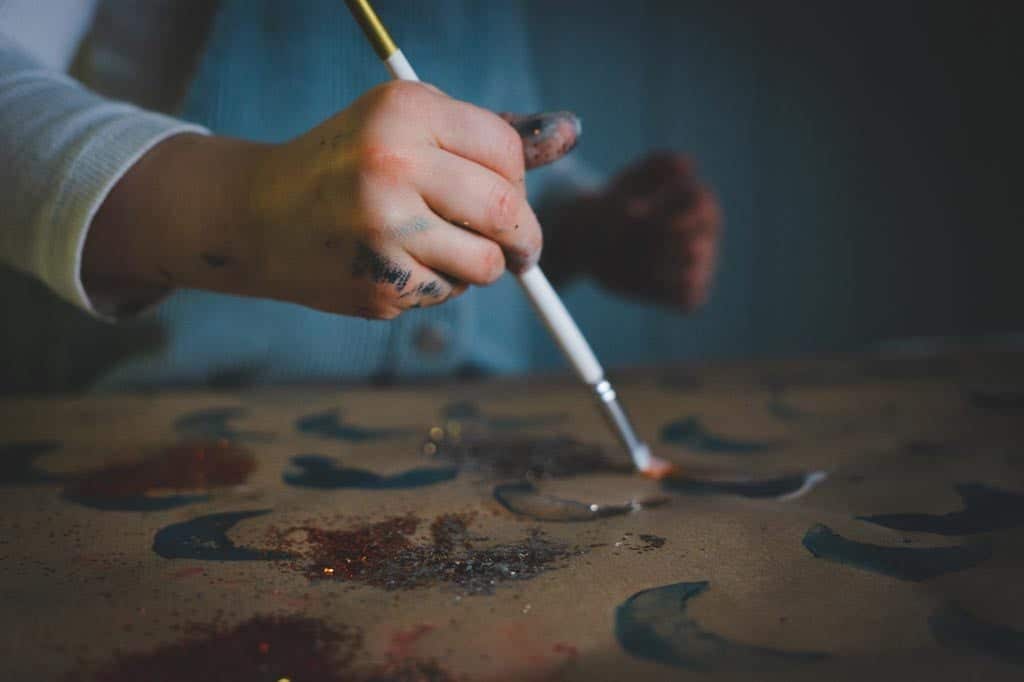Working in a nursery and preschool, I’ve never met a child who wasn’t interested in crafting in some way. Of course, I’ve encountered children, especially older ones, who stubbornly claimed they didn’t like drawing or refused to colour a winter snowman. However, those same children always found crafting activities they enjoyed and used the crayons with a spark in their eyes, driven by their own creative impulses.
Inviting children into the world of crafting requires openness from parents and caregivers, avoiding limitations of traditional uses of craft materials. By following the child’s interests and readiness, instead of offering only specific “close-ended” activities randomly found online, you’ll discover just how much your child needed creative exploration.
From Small Creations to Big Discoveries
Inviting your child into the world of crafting isn’t just about nurturing their artistic development or perhaps sparking a love for art. Every child has a natural need to create and explore crafting materials, regardless of whether they become an artist or art enthusiast in the future. Why? Children have an innate desire to learn and acquire new skills. Crafting meets those needs, providing a space for big discoveries and the development of a wide range of abilities. It’s a powerful educational tool.
This article will guide you in introducing your child to the magical world of crafting.

The Benefits of Crafting for Toddlers
- Self-expression and self-discovery: Crafting with toddlers offers many benefits beyond creating a nice picture. It allows them to express themselves and discover who they are through art.
- Motor skill development: Crafting activities help improve fine motor skills, as children learn to handle scissors, glue paper, or mould clay. These activities will soon help them master writing.
- Cognitive development: Crafting also supports cognitive growth, encouraging problem-solving, creativity, and the use of imagination. When a child feels like the creator of something special, they develop a sense of autonomy, build self-confidence, and cultivate internal motivation.
- Concentration training: Crafting fosters concentration and patience as children work through the process of creating their little masterpiece. It often has a calming effect on the nervous system, promoting relaxation.
- Understanding your child: Finally, creative projects can offer valuable insights into your child’s interests, development, and any challenges they may face—if you become a keen observer!

Creating a Child-Friendly Crafting Space
If you want to engage your child in crafting activities, a good starting point is to set up a dedicated, child-friendly crafting space. This doesn’t necessarily mean giving up an entire room—a small table and drawers or shelves will suffice. A good idea is to create a defined area, perhaps by positioning a chest of drawers to separate this crafting zone from the rest of the room. Try to ensure that this space gets plenty of natural light. A well-lit area can stimulate curiosity and help in distinguishing colours.
Make sure the space is safe for your child. Choose non-toxic crafting materials appropriate for their age and keep them within their reach, so they know where to find things. If something is stored in a closed container, you can label it with a printed picture or a hand-drawn label showing the contents. Keep sharp or small items out of reach. Organise materials into separate containers (preferably transparent), making them easy to find and tidy up.
Have something washable or disposable on hand to cover the floor and table. You might also consider using aprons for your child. Remember, it’s not about keeping the space picture-perfect. The goal is to create a nurturing environment where your child can freely explore and express their creativity, without you worrying about wiping paint off the light-coloured floors or interrupting them every few minutes with, “Be careful!”, “Roll up your sleeves!”, or “Don’t make a mess!”.

Essential Items for Your Child’s Art Corner
Whether you decide to create a new crafting area, enhance a shelf, or get a special craft trolley for your child, here are a few essential groups of items to have on hand that will spark creativity and offer countless hours of crafting fun:
- Non-toxic crafting supplies: washable paints, safe glues, glitter, thick crayons for children
- Modelling dough: homemade from time to time or store-bought
- Paper: white, coloured, and ideally large rolls of paper
- Textured materials: fabric scraps, felt, ribbons, pieces of cardboard
- Loose parts: pipe cleaners, string, buttons, leaves, sticks, shells, pinecones, chestnuts, toilet paper rolls
- Accessories: brushes, paint palettes, clay tools, child-safe scissors, adhesive tape
However, don’t forget to supervise the use of small items like buttons, as they may pose a choking hazard.

I Have Everything. What Now?
Once you’ve created an inspiring space with materials within your child’s reach, the most important thing is to give them the freedom to play. Let your child choose which items to use and how to use them, as well as decide when they want to play. Your main role is to observe and ensure their safety.
From time to time, you can rotate materials, but it’s important to keep basic supplies (like paper and crayons) accessible at all times. Loose parts, on the other hand, can be swapped out and refreshed periodically.
You can also introduce your own idea now and then—for example, by starting a specific type of collage yourself or printing an inspiration picture and placing it on the table along with the necessary materials. You can show your child how you paint something specific or what you use glitter for, but the key is not to interrupt them. Observe especially when your little one starts to focus and create independently.
Remember, in your child’s little art studio, not everything will go according to plan or meet your expectations. Embrace their unexpected ideas and celebrate their creativity. The process, not the product, is what matters most.
Final Word
In preschools and schools inspired by the Reggio Emilia approach, there’s always a dedicated space where children can play with art, called the “Atelier.” It’s usually a large room, but if space is limited, teachers carve out at least a small part of the classroom for it. I encourage you to create a little atelier in your home.
It may not be the tidiest corner, but it will surely be one that provides enriching experiences for your child!

Have you run out of ideas?
What if you didn’t have to trawl the internet for play inspiration? What if your child’s freely-chosen activities were simple to set up, educational and deeply engaging?
How would that change things?
Our courses, A Year With My Child, Get Set Five and 5 Plus are designed for parents of toddlers, preschoolers and the over 5s and they’re packed full of fun and sensible advice.
Enter your email and we’ll send you free modules from each course. And then sit back and relax as your child learns to make her own fun.




